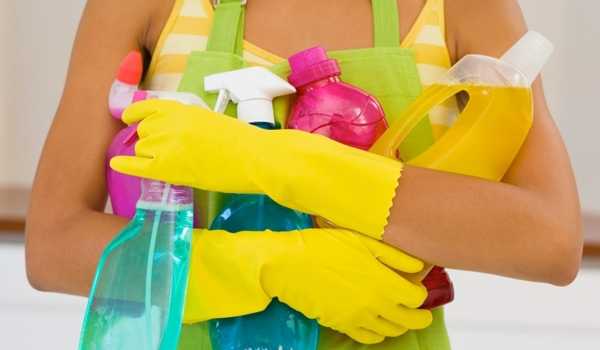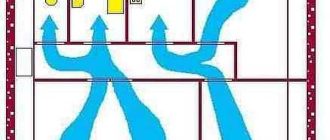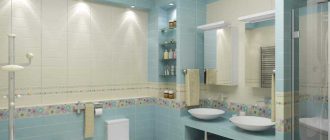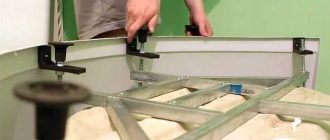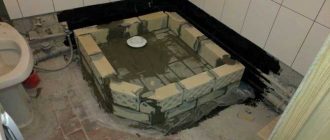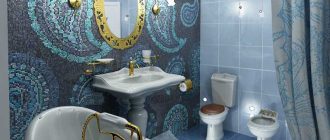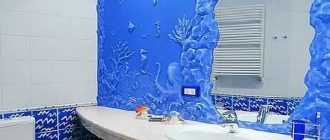In the process of operation or after repair, there is a need to clean the tiles in the bathroom. What are the means, how to use them – we will discuss in the article.
Contenido del artículo
How to remove the plaque on the tiles
From contact with water with a large amount of salts on the surface of the tiles and sanitary ware remain murky traces. If they are not removed, they form a loose plaque, which significantly spoils the appearance. The color of the plaque can be different – white, yellowish, gray brownish, etc. It depends on the type of salts in the water. Since the plaque has a different composition, in different cases, an effective remedy has to be selected by experience.
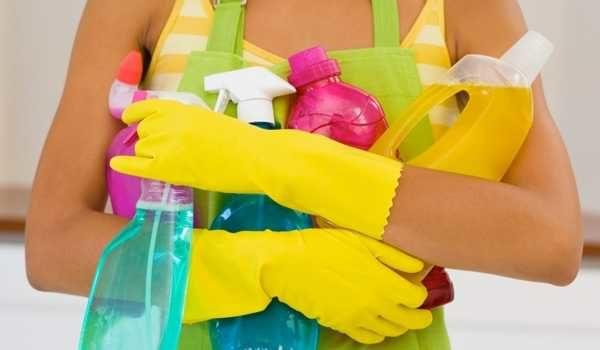
Store remedies
In stores there is a large selection of means that can be used to clean the tiles in the bathroom. Some of them are imported, some – domestic production. There are special compositions for cleaning from lime scale, there are those called “for baths and showers”.
In some cases, compositions for cleaning toilets and other sanitary ware can cope with limescale. For example, you can use diluted ordinary “Belizna”, “Domestos”, “Toilet Duck” and other similar means. Only one caution: if the joints between the tiles are filled with light grout, choose a detergent without dye. On porcelain or earthenware it does not leave traces, but it can color the grout. Then you will have to bleach the seams, which is also not easy.
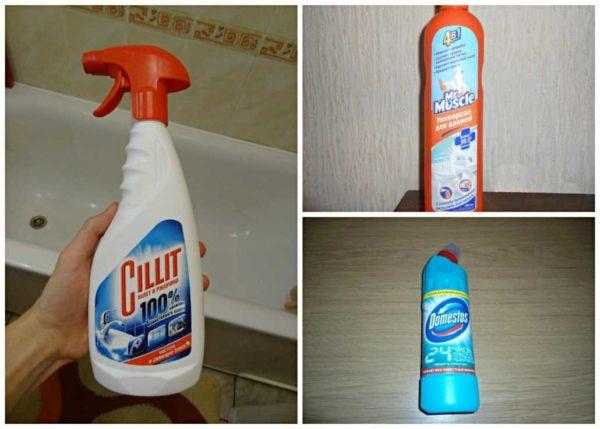
These products contain chlorine or its derivatives and disinfect the room at the same time. They are diluted with water, applied to the walls with a sponge. To speed up the process, you can pour the solution into a sprayer, but it will be difficult to breathe and it is better to wear a mask or respirator, and gloves on your hands. Then it is necessary to wait a few minutes, wash off with a wet sponge, and then wipe dry. In some areas where deposits are most intense, it may be necessary to re-treat. You can rub the heavily soiled area with the back (hard) side of the sponge. It is not always safe to use metal scrapers – they can damage the enamel.
It will also be necessary to clean tile with the help of special means. Their label describes the method of application, but usually differs only in the time that the composition should remain on the walls.
| Nombre | Purpose | Volume | Precio | Country of manufacturer |
|---|---|---|---|---|
| HG | For descaling | 500 ml | 424 rubles | Netherlands |
| CillitBang (sprayer) | Universal descaler and rust remover | 750 ml | 299 rubles | Rusia |
| Frosch (environmentally friendly product) | Bath and shower cleaner | 500 ml | 279 rubles | Alemania |
| Cif | Scale and Dirt Cleaner Cream | 500 ml | 235 rubles | Hungary |
| Flat | Gel for rust and lime stone removal | 500 ml | 90 rubles | Rusia |
| Ecological spray Ecover | Removes lime scale, soap residues, rust stains, gives shine and gloss. | 500 ml | 434 rubles | Belgium |
| Nordland | Removes limescale deposits, water stone, soap residue, rust stains | 500 ml | 353 rub | Alemania |
Often there are positive and negative reviews for the same product. This is mainly due to different origin of stains and sweat. Some products cope with some, others not. Determine this can only be determined by experience or by carefully reading the description.
Folk remedies
If you carefully read the composition of store means, there are mostly substances that are in every household, and if they are not, then you can buy them for very little money. Most often in the composition there is citric acid. Here it is the leader among folk remedies for removing lime scale. You can also try vinegar or lemon juice. Table vinegar with a concentration of 6% or 9% can not be diluted. Citric acid must be diluted. If it is a powder, then a glass of water will go a teaspoon, if citric acid in a diluted state – you need to look at the concentration. The final solution should have 6-10% of acid. In the resulting solution soak a sponge or rag and wipe the surface, moistening well those places where the sweat is more intense. Further the process is already known.
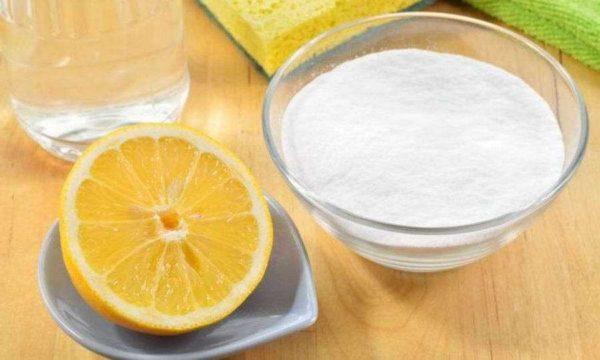
The usual baking soda copes well with soap scum. It is taken on a damp sponge / rag, wipe the walls, then – rinse.
Sometimes it helps to first rub the tiles with baking soda, then wipe with vinegar. A chemical reaction begins, during which the plaque is destroyed. In general, and here it is necessary to try, but the means are pennies.
A lot of unpleasant moments arise if you need to clean the tiles in the bathroom of dark color with a glossy surface. It shows not only plaque, but also lint from the fabric. You can get rid of lint by using microfiber cloths, and alcohol can add shine. Using medical or food alcohol is too wasteful, you can add ammonia to water and spray it on the walls cleaned of plaque, then wipe with microfiber. The shine is guaranteed.
Cleaning floor tile joints
Floor tiles are easier to care for – they are wiped more often, so plaque simply does not form. There are usually problems with the seams. If they are wiped with a light-colored compound, then after some time it darkens and even a clean floor looks unkempt. To correct the situation, you can use the same means as for cleaning tiles from plaque and from improvised means will be suitable soda.
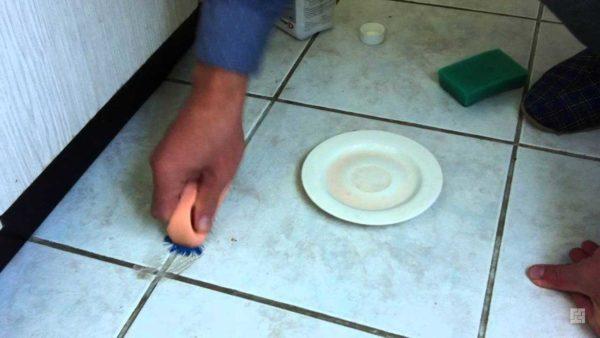
To work will need a narrow brush, you can use a toothbrush with stiff bristles. The brush is wetted, you can dip it in detergent or diluted powder, then – in soda. After – clean the seams, wiping constantly foam and dirt.
How to wash off the fungus
The presence of fungus in the bathroom is a consequence of poor ventilation. If this is not corrected, you can not get rid of it. You can only periodically kill its visible manifestations. On how to fight fungus in the bathroom read here, and in this section we will tell you what is good to remove the blackness that it leaves.
Help all means that contain chlorine or chlorinol: Domestos, Utenok, Belizna, etc. For treatment, the means is diluted, then they are treated blackened surfaces. Seams between tiles often have to be treated with a toothbrush, otherwise the plaque will not disappear. As the impact, the plaque disappears (discolored), after which you can wipe with a cloth with water, then – dry.
Alcohol and vinegar also help. In this case, it is better not to dilute them, because they treat small areas, usually – the joints between the tiles. Helps a solution of borax: for 2.5 liters of water to take 200 gr of powder, apply to the affected surfaces and leave to dry. You can not wash off, but if it spoils the appearance – remove as usual: water, then a dry cloth.
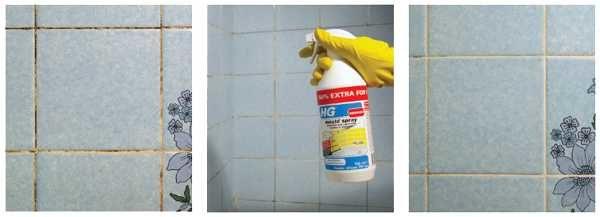
Treatment with a hydrogen peroxide solution can help. You can take a ready-made pharmacy solution, and you can dissolve the tablets of Hydroperite in water, making a more concentrated solution. Just remember that you need to work with gloves: it is also a poisonous substance.
You can also find store remedies against mold in the bathroom. Usually they are called so. There are the following brands: Unicum, Bagi “Anti-mold”, Magiclean, Bon “Antifungus”, DR.BECKMANN, Mellerud and many others. Their composition includes: chlorine, citric acid, active oxygen (hydrogen peroxide) and some other substances. They cope quite well with the external manifestations of mold, but do not destroy it.
What to clean the tiles in the bathroom after repair
Often after repairs on the surfaces there are traces of cement, tile glue and other construction compositions and mixtures. Clean the tiles in the bathroom after the mixtures have dried – a very difficult task. There are in stores flush for cement. For example Atlas, Olympus, Docker Zement, Docker Epoxy (G), Keranet Mapeib and others. They are applied, wait for some time, then remove the crumbling cement mortar with a stiff brush.
Dried cement and adhesive sweepings on its basis are removed with the help of acid solutions. Any acid is suitable – from diluted hydrochloric acid to citric acid and ordinary vinegar. Acids should be handled with care: with gloves and a respirator with good ventilation. As the acid will corrode the cement, it can be removed, after cleaning – wash it off with water.
Tile adhesive, due to the presence of special additives, can not always be removed like ordinary grout. In construction stores you can find special cleaning products. For example, Tiprom-OC, Keranet, AtlasSzop and others. They are applied to the surface, kept for some time (indicated in the instructions) then the softened composition is removed with a little effort. This way to clean tiles in the bathroom from tile glue is suitable for contamination of the front surface.
Sometimes there is a situation when the tile fell off together with the glue. Having cleaned, it should be put in place. Soften the glue with chemical means is too wasteful – they are not cheap. It remains mechanical removal. If the layer is large – more than 0.5 cm, it is cut into squares with a diamond disk. After putting the treated tile on a rib, chisel scalp pieces of glue. What did not break off can be left or removed with a grinding disk. With such work there will be a lot of dust, so it is better to do it outside. Reduce the amount of dust and make the task a little easier by wetting the tiles in water. Some of its amount of glue will absorb, although it is positioned as moisture-resistant.
If the layer of glue is thin – you can try to peel it off in layers, if it “won’t go” – sanding. It is unrealistic to process a large number of tiles in this way, but a few pieces can be prepared.

